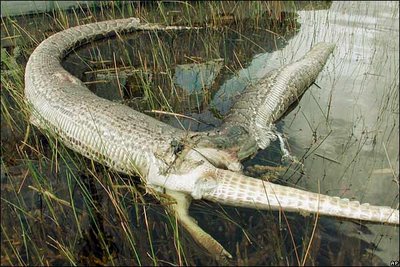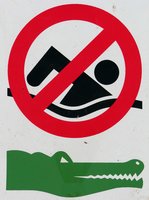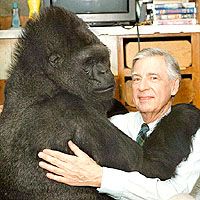Shark vs octopus
Shark vs octopus.
Creepy.
An impromptu stomp through the world of Australian Science and Science Policy, and angry young man peer-reviews the science media. We have to cop it, so should they...

"SCIENTISTS can't stop them and they can't predict them. They can, however, send an alarm when a powerful tsunami is heading to shore. But for residents of southern Java there was no such warning on Monday when a near 3m high wall of water, triggered by a magnitude 7.7 earthquake 10km below the seabed, crashed on to a 300km stretch along scenic Pangandaran beach in Indonesia."From The Australian. The lack of warning is not really a problem with the science - the detection systems are in place - even though in this region the plan's still in its infancy. None of the teams who detected in the earthquake could estimate the tsunami's size. Again from The Australian:
"It was the Hawaiian centre and Japan's Meteorological Agency that picked up Monday's quake and alerted the world. Both organisations issued warnings within 17 minutes of the quake, more than a half-hour before the tsunami hit Java's coastline.I've had difficulty finding the time difference between the quake, and the tsunami arriving at Java or Christmas island. Unconfirmed press reports indicate a period of 1 hour between the quake and the tsunami's arrival at the Javan coastline (240km), and 17 minutes to reach Christmas Island (225km). However, ABC news reports that Christmas Island had 20 minutes warning to get to higher ground. There seems to be discrepancy in the velocity - can changes in the wave speed explain it?
In the open ocean a tsunami travels, on average, 800km/h. It slows when it reaches the shallower water of a coastline. "That's why the wave builds up," Jepsen says."
Indonesian government science and technology minister Kusmayanto Kadiman confirmed that Indonesian officials had received bulletins from both the Pacific Tsunami Warning Center in Hawaii and the Japan Meteorological Agency twenty minutes before the first tsunami wave struck but were too busy monitoring the quake aftershocks to issue warnings. [1]According to an AP report, Science and Technology Minister Kusmayanto Kadiman stated that Indonesia received the warning bulletins 45 minutes before the tsunami hit. However, Kadiman indicated that the government did not publicize the bulletins because they did not want to cause unnecessary alarm. [2]
Edi Prihantoro, an official at Indonesia’s Ministry of Research and Technology that oversees a national warning project, said the southern Java area had no system to warn people of coming waves.
As part of a five-year project to install tsunami buoys around the archipelago, Indonesia deployed two such devices off the island of Sumatra last year. However, when asked how many of the deployed devices were operational, Prihantoro replied: “None.” He continued, “We need at least 22 buoys to cover all of Indonesia. We have received two from Germany and they were deployed months ago. However, both of them are damaged now.” Both devices have since been decommissioned and one of them is awaiting repairs. [3]
References
"However, a history of bad investments, financial mismanagement, overspending and corruption has reduced the Trust's fixed and current assets. For example, Nauru House in Melbourne was sold in 2004 to finance debts and Air Nauru's last Boeing 737 was repossessed in December 2005... Nauru currently lacks money to perform many of the basic functions of government, the national Bank of Nauru is insolvent, and GDP per capita has fallen to US$5,000 per annum."Not a great outlook. Chronic corruption and a "provided-for" mentality means it going to be hard for this little nation to pick up its feet. Its attempt at offering a no-questions-asked tax haven for foreign nationals led to millions of dollars being laundered by the Russian mafia through Nauru. International pressure has since put a stop to this. Now it relies on Australia's unwanted refugee's for income.
"Barlow fails to address what I refer to as Australia's inventory problem, the conspicuous lack of internationally successful high-value-added brand-name goods and services. The Netherlands, Sweden, Switzerland and Finland, which all have smaller populations than Australia, make products that sell internationally on reputation, rather than price. Where are the Australian equivalents of Philips, Volvo, Scania, Hasselblad, Nestlé, Roche or Nokia?"Australia had an educated population clearly adept enough to ride the internet bubble, or capitalise on the communications revolution, but in investment it never leads - it just follows by example. A company like Nokia, for instance, would have a hard time starting up in Australia, yet its the biggest export Finland has. A little bit of forward thinking is required, short-sightedness is not just something you can fix with glasses.

(from smh).
Though many hundreds more people die in car accidents every year than are killed by crocs, crocodile attacks touch upon a primal fear base of humans. We are still (rightly) scared of being eaten alive. And this sort of frequency of attack is alarming, if only for the fact that its increasing.


 Seriously. Crocodiles have only 2 ways of interacting with other species: fear it or eat it. During the 1960's and the decimation of Australia's crocs due to unrestricted hunting, the big crocs got cagey around anything with two legs holding a pointy stick. However, the ones born since then don't know or care, and regard us smaller humans as home-delivery. This lack of fear of humans is due in large part to familiarity, and the fact that we feed them:
Seriously. Crocodiles have only 2 ways of interacting with other species: fear it or eat it. During the 1960's and the decimation of Australia's crocs due to unrestricted hunting, the big crocs got cagey around anything with two legs holding a pointy stick. However, the ones born since then don't know or care, and regard us smaller humans as home-delivery. This lack of fear of humans is due in large part to familiarity, and the fact that we feed them:

"8. On the evening of 22 October, the group camped in the designated camping ground at Sandy Billabong. They had dinner at about 9 pm. At about 10.30 pm on that night, Mr Robless suggested they could swim off a sandbar situated on Nourlangie Creek approximately 1.5 kilometres from the camp site. He led the group to the location and seven members of the group commenced to swim in the Creek, whilst two remained on the bank. After the group had been swimming for a short time, Mr Robless left them there in order to make contact with a guide from Gondwana who was leading another tour group in the area.
9. In Mr Robless's absence, a large saltwater crocodile swam amongst the group and dragged the deceased below the water. She was not immediately seen to be missing. It took some time for the remaining members of the group to realise something was amiss. Certain members of the group have a recollection of the deceased giving a shout or yelp. Those who heard that sound initially thought it was part of the general “skylarking”. Another member of the group had felt something brush against her legs at about the time the deceased disappeared. Yet another member of the group thought he had seen something large swimming from the area. The realisation dawned that the deceased had likely been taken by a crocodile."
Pretty horrific. She was taken under and no-one even realised. Plus they were swimming at night, in a crocodile infested waterhole, which had signs up... It really should never have happened. Not that its any condolence to the family, but they got the croc that took her; a 4m+ croc weighing in at 400kg - not in the best shape either, which may have been why it was hunting humans (not that crocs need much incentive).

Fourteen years ago, during the 1992 campaign, the current president's father, George Herbert Walker Bush, dismissed Mr. Gore as "Ozone Man" — if the Clinton-Gore ticket were elected, he suggested, "we'll be up to our neck in owls and out of work for every American" — but with the emerging consensus on global warming today, Mr. Gore's passionate warnings about climate change seem increasingly prescient.Those without the time to sit down and plough through his book, though, can now see the movie instead. And no, not kidding.











